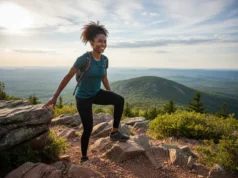In this article
Starting your hike in the cool, misty dawn, the long pant legs a welcome shield against the morning chill and abrasive brush. By midday, the sun is high and relentless, and with a few quick zips, your pants transform into shorts, offering immediate relief. This is the promise of convertible hiking pants—ultimate versatility and protection from hazards like sun exposure, ticks, and poison oak. But do they deliver on this promise without compromising on comfort, durability, and critical trail features? This guide cuts through the marketing to answer the core question—are zip-off pants worth it?—equipping you with the framework to find the best convertible hiking pants for your adventures.
Not All Pants Are Equal: We’ll break down the six critical performance criteria—from Comfort & Mobility to Conversion Design—that separate high-performers from trail failures.
Know Your Hiker Persona: Discover whether you’re a Long-Distance Thru-Hiker, a Value-Driven Day Hiker, or a style-conscious Adventure Traveler, and see which pants are engineered for your specific needs.
Data-Driven Recommendations: Skip the guesswork. We provide a curated list of the top convertible pants for 2025, with scores and specs pulled from extensive research and expert analysis.
The Ultimate Verdict: We’ll deliver a clear conclusion on when convertible pants are a brilliant gear choice and when an alternative system (like shorts + wind pants) might be superior.
How to Choose the Right Convertible Hiking Pants: An Expert’s Framework
To make a smart, confident choice in your gear selection, you need to look past the marketing and deconstruct what truly makes a great pair of hiking pants. This objective knowledge is the foundation of a good gear investment.
Why Do Durability & Material Composition Matter Most?
A pant’s fabric is its foundation, dictating everything from its comfortable fit to its lifespan. The primary choice you’ll face is between nylon and polyester. Nylon is the undisputed champion of abrasion resistance, making it ideal for scrambling over rock or pushing through dense vegetation, brush, or chaparral. A durable synthetic material is also crucial for navigating unexpected trail blowdowns. Polyester, while less rugged, often excels at moisture-wicking and can feel softer against the skin. Fabric thickness, measured in denier, also plays a key role—a higher denier means more durability but often less breathability and slower drying speed.
The secret ingredient for modern performance is stretchy fabric. A small percentage of spandex or elastane woven into the material dramatically enhances mobility, allowing for unrestricted movement. In contrast, non-stretchy fabric can feel restrictive when high-stepping over logs or navigating technical terrain. However, there’s a trade-off; a very high stretch percentage can sometimes lead to a baggy fit or the fabric losing its shape over time.
Pro-Tip: When examining a pair of pants, don’t just look at the fabric. Look at the seams. High-quality pants will have reinforced stitching, known as bar tacks, at high-stress points like the corners of pockets, the belt loops, and the crotch gusset. This is a tell-tale sign of thoughtful, durable construction.
Ultimately, robust materials are useless without quality construction. Experienced hikers don’t just measure a pant’s worth in dollars; they measure it in “trail miles.” A truly durable pant is a 3,000-mile pant, one that can withstand a full thru-hike like the Colorado Trail and keep going. This trail-specific durability, or longevity by terrain type, is what separates gear that lasts from gear that fails.
Now that you understand the foundation of a pant’s toughness, let’s explore how its design impacts your movement and comfort on the trail. A pant’s overall performance as part of a layering system connects our discussion of pant materials to the foundational concept of how hiking trousers integrate into a complete clothing system for varied conditions.
How Does Conversion Design Separate the Best from the Rest?
The quality of the convertible zip-off legs is what defines these pants, and its design is where excellence is truly separated from mediocrity. For any serious hiker, vertical side zippers on the lower leg—ankle zips or a bottom zipper—are a non-negotiable feature. They allow you to remove the zip-off legs without the massive inconvenience of taking off your muddy hiking shoes or boots. A pant without this feature is fundamentally flawed for dynamic trail conditions.
Expert insight reveals that the zipper’s orientation is also critical. The functionally superior design has zippers that open from the back of the knee and travel forward. This allows you to partially unzip them for highly effective venting of the popliteal fossa, a major heat-release point behind your knee. This design also protects the zipper from getting snagged on brush as you walk. Simple user-friendly features, like color-coded zipper pulls, eliminate the frustrating trial-and-error of reattaching the correct leg to the correct side.
Finally, a quality design must prioritize comfort and sun-blocking protection. The main conversion zipper should always have a protective fabric flap or “zipper garage” covering it. This small detail is crucial for preventing the cold, rough plastic of the zipper from chafing against your skin over a long day of hiking. An authoritative explanation of UPF 50+ protection, a key weather-protection feature, can be found on the EPA’s site covering sun protection factor (SPF) and ultraviolet protection factor (UPF).
Beyond the core conversion feature, a pant’s utility is defined by its ability to protect you from the elements and carry essential gear.
What Features & Storage Options Should You Look For?
When it comes to pockets, it’s not about the number, but their design and placement. A truly functional layout includes deep hand pockets that can hold items without them spilling out, at least one secure zippered cargo or thigh pocket that is large enough for a map or smartphone, and secure back pockets. These utility pockets are essential for keeping small items accessible.
The integrated belt is another feature that requires careful consideration. While convenient, a bulky, hard plastic buckle can create a painful pressure point directly under your backpack’s hip belt after hours on the trail. A far more comfortable and functional design uses a flat, simple webbing-based belt that lies flush against your body.
Pro-Tip: When trying on pants you intend to use for backpacking, wear them with your pack’s hip belt cinched down in the store. Walk around for a few minutes. This is the only way to know for sure if the belt buckle, pant snaps, or pocket zippers will create uncomfortable hot spots.
Finally, look for adjustments at the ankle cuffs. Features like snaps at the bottom of pant legs or drawcords are a valuable addition, allowing you to cinch the pants tightly around your boots. This simple feature is incredibly effective at keeping out trail debris and is a cornerstone of safety preparedness, especially for tick avoidance and poison oak avoidance. Pairing pants with gaiters offers an even higher level of protection, a key component of responsible practices like Leave No Trace.
With this expert framework in hand, you’re ready to see how we applied it to the top products on the market.
Our Selection Process: How We Built This Guide
To build absolute trust, we believe in transparently detailing our rigorous research and curation process. Our commitment to objectivity is central to our gear selection advice. This guide is the result of an exhaustive analysis of expert testing methodologies, long-term user reviews from communities of dedicated hikers, and detailed brand comparisons. Our goal is to empower you with knowledge, not just sell you a product.
Every pant we considered was systematically judged against the six critical performance criteria and four key specifications detailed in the framework you just read. We started with a broad market survey of over 50 models and then filtered that list down to the highest-rated and most discussed products. From there, we curated the final recommendations by matching each pant’s specific strengths to the distinct needs of three core hiker personas.
A Note on Affiliate Links: If you choose to purchase a product through a link in this article, we may earn a small commission at no extra cost to you. This helps support our work, but our recommendations are always driven by our independent research and analysis first.
The Best Convertible Hiking Pants of 2025: Our Top Recommendations for Every Need
Here we present the curated top recommendations for the key user personas, providing all the data needed for an informed decision.
Our Top Picks for The Long-Distance Thru-Hiker
This user, often engaged in long-distance backpacking or multi-day treks, demands an optimized balance of low weight, absolute durability, and functional reliability for multi-month journeys on trails like the Continental Divide Trail. They need gear that performs without question, day after day.
Our Top Picks for The Value-Driven Day Hiker
This user seeks the best combination of price, versatility, and all-around functionality for frequent but less-demanding use. They need a reliable pant that gets the job done without breaking the bank.
Conclusion
Convertible pants offer undeniable versatility, making them an excellent choice for day hikers and travelers dealing with fluctuating temperatures. The best designs prioritize function with features like ankle zips for boot-on conversion and back-of-knee zippers for superior venting. For the most demanding users engaged in long-distance backpacking, the added weight and potential failure points of zippers mean a modular system of shorts and separate wind pants is often a superior choice. Ultimately, the value of convertible pants is highly dependent on your specific needs. The ideal choice aligns perfectly with your primary activities, whether that’s prioritizing value (like the REI Sahara pants), mobility (OR Ferrosi), or travel-specific features (Royal Robbins).
Choosing the right gear is a key step in preparing for any adventure. Now that you’re armed with the data, find the pant that matches your hiking style and get ready to hit the trail with confidence.
Frequently Asked Questions about Convertible Hiking Pants
Can you remove the legs of convertible pants without taking off your boots?
This depends entirely on the design; look for models that specifically include vertical zippers on the lower leg (ankle zips). Pants like the REI Co-op Sahara Convertible are designed for this, while many others, like the Patagonia Quandary, are not and will require you to remove your footwear. This feature is a critical dividing line between convenient and inconvenient designs.
Are convertible hiking pants good for thru-hiking?
While some thru-hikers use them, many ultralight-focused hikers reject them due to the extra weight and potential for zipper failure. The added complexity introduces another point where gear can break down on a long journey. For this reason, the most demanding thru-hikers often prefer a lighter, more reliable system of dedicated hiking shorts paired with separate ultralight wind pants.
What is the most important feature in a convertible pant’s design?
Beyond basic material quality, the most critical design feature is the zipper system. This includes ankle zips for convenience and, ideally, a zipper path that starts behind the knee for effective, snag-free venting. A front-opening zipper, like that on the Prana Stretch Zion Convertible, is a known functional flaw for serious use because it’s prone to snagging and is less effective for thermal regulation.
How do I stop the zippers on convertible pants from chafing?
High-quality convertible pants prevent chafing by including a protective fabric flap (a “zipper garage” or storm flap) that covers the zipper and keeps it from making direct contact with your skin. If you experience chafing, it is often a sign of a lower-quality design or an improper fit where the zipper is under too much tension against your leg.
Risk Disclaimer: Hiking, trekking, backpacking, and all related outdoor activities involve inherent risks which may result in serious injury, illness, or death. The information provided on The Hiking Tribe is for educational and informational purposes only. While we strive for accuracy, information on trails, gear, techniques, and safety is not a substitute for your own best judgment and thorough preparation. Trail conditions, weather, and other environmental factors change rapidly and may differ from what is described on this site. Always check with official sources like park services for the most current alerts and conditions. Never undertake a hike beyond your abilities and always be prepared for the unexpected. By using this website, you agree that you are solely responsible for your own safety. Any reliance you place on our content is strictly at your own risk, and you assume all liability for your actions and decisions in the outdoors. The Hiking Tribe and its authors will not be held liable for any injury, damage, or loss sustained in connection with the use of the information herein.
Affiliate Disclosure: We are a participant in the Amazon Services LLC Associates Program, an affiliate advertising program designed to provide a means for us to earn advertising fees by advertising and linking to Amazon.com. As an Amazon Associate, we earn from qualifying purchases. We also participate in other affiliate programs and may receive a commission on products purchased through our links, at no extra cost to you. Additional terms are found in the terms of service.





